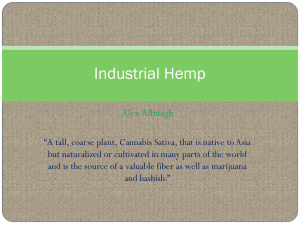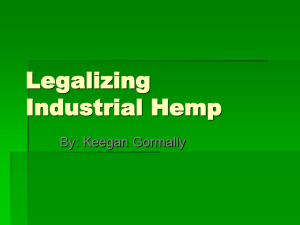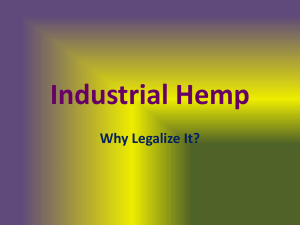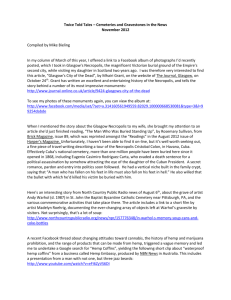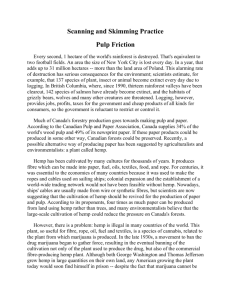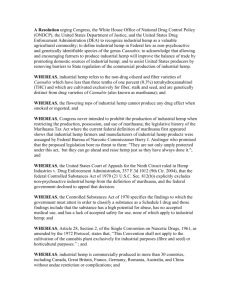Facts About Hemp
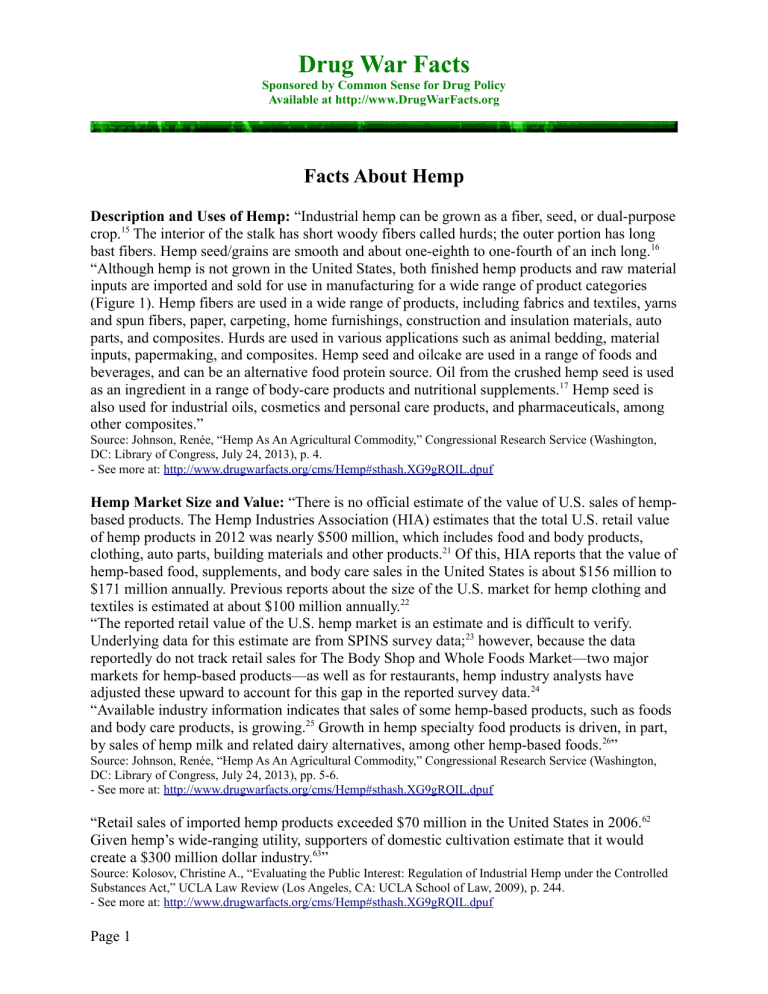
Drug War Facts
Sponsored by Common Sense for Drug Policy
Available at http://www.DrugWarFacts.org
Facts About Hemp
Description and Uses of Hemp: “Industrial hemp can be grown as a fiber, seed, or dual-purpose crop.
15 The interior of the stalk has short woody fibers called hurds; the outer portion has long bast fibers. Hemp seed/grains are smooth and about one-eighth to one-fourth of an inch long.
16
“Although hemp is not grown in the United States, both finished hemp products and raw material inputs are imported and sold for use in manufacturing for a wide range of product categories
(Figure 1). Hemp fibers are used in a wide range of products, including fabrics and textiles, yarns and spun fibers, paper, carpeting, home furnishings, construction and insulation materials, auto parts, and composites. Hurds are used in various applications such as animal bedding, material inputs, papermaking, and composites. Hemp seed and oilcake are used in a range of foods and beverages, and can be an alternative food protein source. Oil from the crushed hemp seed is used as an ingredient in a range of body-care products and nutritional supplements.
17 Hemp seed is also used for industrial oils, cosmetics and personal care products, and pharmaceuticals, among other composites.”
Source: Johnson, Renée, “Hemp As An Agricultural Commodity,” Congressional Research Service (Washington,
DC: Library of Congress, July 24, 2013), p. 4.
- See more at: http://www.drugwarfacts.org/cms/Hemp#sthash.XG9gRQIL.dpuf
Hemp Market Size and Value: “There is no official estimate of the value of U.S. sales of hempbased products. The Hemp Industries Association (HIA) estimates that the total U.S. retail value of hemp products in 2012 was nearly $500 million, which includes food and body products, clothing, auto parts, building materials and other products.
21 Of this, HIA reports that the value of hemp-based food, supplements, and body care sales in the United States is about $156 million to
$171 million annually. Previous reports about the size of the U.S. market for hemp clothing and textiles is estimated at about $100 million annually.
22
“The reported retail value of the U.S. hemp market is an estimate and is difficult to verify.
Underlying data for this estimate are from SPINS survey data; 23 however, because the data reportedly do not track retail sales for The Body Shop and Whole Foods Market—two major markets for hemp-based products—as well as for restaurants, hemp industry analysts have adjusted these upward to account for this gap in the reported survey data.
24
“Available industry information indicates that sales of some hemp-based products, such as foods and body care products, is growing.
25 Growth in hemp specialty food products is driven, in part, by sales of hemp milk and related dairy alternatives, among other hemp-based foods.
26 ”
Source: Johnson, Renée, “Hemp As An Agricultural Commodity,” Congressional Research Service (Washington,
DC: Library of Congress, July 24, 2013), pp. 5-6.
- See more at: http://www.drugwarfacts.org/cms/Hemp#sthash.XG9gRQIL.dpuf
“Retail sales of imported hemp products exceeded $70 million in the United States in 2006.
62
Given hemp’s wide-ranging utility, supporters of domestic cultivation estimate that it would create a $300 million dollar industry.
63 ”
Source: Kolosov, Christine A., “Evaluating the Public Interest: Regulation of Industrial Hemp under the Controlled
Substances Act,” UCLA Law Review (Los Angeles, CA: UCLA School of Law, 2009), p. 244.
- See more at: http://www.drugwarfacts.org/cms/Hemp#sthash.XG9gRQIL.dpuf
Page 1
Drug War Facts
Sponsored by Common Sense for Drug Policy
Available at http://www.DrugWarFacts.org
Production Differences Between Hemp and Marijuana: “Production differences depend on whether the cannabis plant is grown for fiber/oilseed or for medicinal/recreational uses. These differences involve the varieties being grown, the methods used to grow them, and the timing of their harvest (see discussion in 'Hemp' and 'Marijuana,' below). Concerns about cross-pollination among the different varieties are critical. All cannabis plants are open, wind and/or insect pollinated, and thus cross-pollination is possible.
“Because of the compositional differences between the drug and fiber varieties of cannabis, farmers growing either crop would necessarily want to separate production of the different varieties or cultivars. This is particularly true for growers of medicinal or recreational marijuana in an effort to avoid cross-pollination with industrial hemp, which would significantly lower the
THC content and thus degrade the value of the marijuana crop. Likewise, growers of industrial hemp would seek to avoid cross-pollination with marijuana plants, especially given the illegal status of marijuana. Plants grown of oilseed are also marketed according to the purity of the product, and the mixing of off-type genotypes would degrade the value of the crop.
8
“The different cannabis varieties are also harvested at different times (depending on the growing area), increasing the chance of detection of illegal marijuana, if production is commingled.
Because of these differences, many claim that drug varieties of cannabis cannot easily be grown with oilseed or fiber varieties without being easily detected.
9 As discussed below, among the visual plant differences are plant height (hemp is encouraged to grow tall, whereas marijuana is selected to grow short and tightly clustered); cultivation (hemp is grown as a single main stalk with few leaves and branches, whereas marijuana is encouraged to become bushy with many leaves and branches to promote flowers and buds); and planting density (hemp is densely planted to discourage branching and flowering, whereas marijuana plants are well-spaced).”
Source: Johnson, Renée, “Hemp As An Agricultural Commodity,” Congressional Research Service (Washington,
DC: Library of Congress, July 24, 2013), pp. 2-3.
- See more at: http://www.drugwarfacts.org/cms/Hemp#sthash.XG9gRQIL.dpuf
Parts and Products of the Hemp Plant
Hemp Hurds: “Hemp hurd is composed of cellulose-rich, short fibres, and make up approximately 75% of the hemp stalk. They are spongy and absorbent, ideal characteristics in applications such as animal bedding and industrial absorbents. They may also be used to produce low-quality paper. More recently, hemp hurd has been used to produce a concrete-like substance for use in building applications, as well as for insulation and to produce fibreboard.”
Source: “National Industrial Hemp Strategy,” The Agricola Group (Ottawa, Canada: Manitoba Agriculture, Food and Rural Initiative Agriculture and Agri-Food Canada, March 30, 2008), p. 3.
- See more at: http://www.drugwarfacts.org/cms/Hemp#sthash.XG9gRQIL.dpuf
Page 2
Drug War Facts
Sponsored by Common Sense for Drug Policy
Available at http://www.DrugWarFacts.org
Hemp Stalks: “The whole hemp stalk can also be used to produce various biofuels such as biooil (or pyrolytic liquid), cellulosic ethanol, syngas (synthetic gas) and methane. Alternatively, the bast fibre can first be removed for use in high-value fibre applications, and the remaining hurd can then be processed into biofuel. The processes by which hemp is converted to biofuels may also produce valuable chemicals and other materials as bi-products.”
Source: “National Industrial Hemp Strategy,” The Agricola Group (Ottawa, Canada: Manitoba Agriculture, Food and Rural Initiative Agriculture and Agri-Food Canada, March 30, 2008), p. 4.
- See more at: http://www.drugwarfacts.org/cms/Hemp#sthash.XG9gRQIL.dpuf
Hemp Oil: “Hemp oil is extremely nutritious, and is used in foods and nutraceutical products for humans and animals, as well as in personal care products. Hemp oil is also suitable for use in industrial products such as paints, varnishes, inks and industrial lubricants, and can be used to produce biodiesel. The crushed seed meal left over from oil production is frequently used for animal feed.”
Source: “National Industrial Hemp Strategy,” The Agricola Group (Ottawa, Canada: Manitoba Agriculture, Food and Rural Initiative Agriculture and Agri-Food Canada, March 30, 2008), p. 4.
- See more at: http://www.drugwarfacts.org/cms/Hemp#sthash.XG9gRQIL.dpuf
Hemp Bast Fibres: “Hemp bast fibres are among the strongest and most durable of natural fibres, with high tensile strength, wet strength, and other characteristics favourable for various industrial products. It has been estimated that hemp produces three to four times as much useable fibre per acre per year as forests, and the bast fibre contains a low amount of lignin (the natural polymer that binds plant cells together), which allows it to be bleached without the use of chlorine. Hemp bast fibre is used in the production of a wide range of products where its strength and durability are advantageous, including cordage (rope, twine, etc.), specialty papers, fabrics for clothing and other applications, and industrial textiles such as geotextiles and carpeting. The strength of hemp fibre also makes it ideal for use in a range of composites for applications such as moulded car parts and fibreboard for construction.”
Source: “National Industrial Hemp Strategy,” The Agricola Group (Ottawa, Canada: Manitoba Agriculture, Food and Rural Initiative Agriculture and Agri-Food Canada, March 30, 2008), p. 3.
- See more at: http://www.drugwarfacts.org/cms/Hemp#sthash.XG9gRQIL.dpuf
Federal Law and DEA Control Over Hemp Production in the US: “In 1937, Congress passed the first federal law to discourage Cannabis production for marijuana while still permitting industrial uses of the crop (the Marihuana Tax Act; 50 Stat. 551). Under this statute, the government actively encouraged farmers to grow hemp for fiber and oil during World War II.
After the war, competition from synthetic fibers, the Marihuana Tax Act, and increasing public anti-drug sentiment resulted in fewer and fewer acres of hemp being planted, and none at all after
1958.
“Strictly speaking, the Controlled Substances Act of 1970 (CSA, 21 U.S.C. §801 et. seq.) does not make growing hemp illegal; rather, it places strict controls on the production of hemp, making it illegal to grow the crop without a DEA permit.
Page 3
Drug War Facts
Sponsored by Common Sense for Drug Policy
Available at http://www.DrugWarFacts.org
“The CSA adopted the same definition of Cannabis sativa that appeared in the 1937 Marihuana
Tax Act. The definition of “marihuana” (21 U.S.C. §802(16) reads:
The term marihuana means all parts of the plant Cannabis sativa L., whether growing or not; the seeds thereof; the resin extracted from any part of such plant; and every compound, manufacture, salt, derivative, mixture, or preparation of such plant, its seeds or resin. Such term does not include the mature stalks of such plant, fiber produced from such stalks, oil or cake made from the seeds of such plant, any other compound ... or preparation of such mature stalks (except the resin extracted therefrom), fiber, oil, or cake, or the sterilized seed of such plant which is incapable of germination.
“The statute thus retains control over all varieties of the cannabis plant by virtue of including them under the term 'marijuana' and does not distinguish between low- and high-THC varieties.
The language exempts from control the parts of mature plants—stalks, fiber, oil, cake, etc. — intended for industrial uses. Some have argued that the CSA definition exempts industrial hemp under its term exclusions for stalks, fiber, oil and cake, and seeds.
52 DEA refutes this interpretation.
53
“Since federal law prohibits cultivation without a permit, DEA determines whether any industrial hemp production authorized under a state statute is permitted, and it enforces standards governing the security conditions under which the crop must be grown. In other words, a grower needs to get permission from the DEA to grow hemp or faces the possibility of federal charges or property confiscation, regardless of whether the grower has a state-issued permit.
54 ”
Source: Johnson, Renée, “Hemp As An Agricultural Commodity,” Congressional Research Service (Washington,
DC: Library of Congress, July 24, 2013), p. 13.
- See more at: http://www.drugwarfacts.org/cms/Hemp#sthash.XG9gRQIL.dpuf
Learn much more at the Drug War Facts website, http://www.drugwarfacts.org
.
The Hemp section is at http://www.drugwarfacts.org/cms/Hemp .
Remember: Knowledge is power. Stay informed. Get The Facts.
Page 4
